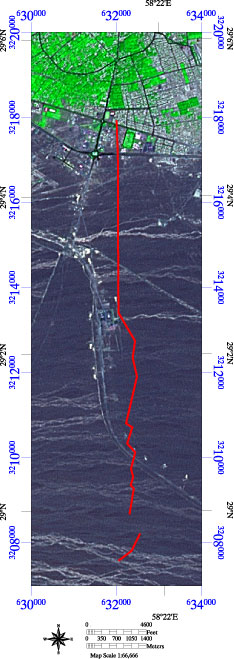Earth Seen 'Healing' After Big Quake

For the first time, scientists have watched as the Earth’s surface “heals” itself following the disruptive jolt of an earthquake, in this case, the 2003 temblor that devastated Bam, Iran.
The fault under the city erupted in a 6.6-magnitude quake on Dec. 26 that year, leveling the town and killing more than 26,000 people. But though devastation was evident, there was no clear fault mark at the surface.
"The fault slipped maybe 2 or 3 meters [6.5 to 10 feet] at depth, but at the surface, when colleagues of mine went out, they found some cracks, but the motion on those cracks is only about up to 25 centimeters [10 inches] or less," said one of the scientists who studied the quake, Eric Fielding of Caltech. "We have some layer of material near the surface that's behaving differently from the fault at depth."
Seismologists had noticed similar mismatches between depth and surface fault movements during other earthquakes. Because eventually both layers of the fault have to match up, the question was, "what's happening in this surface layer?" Fielding said.
Expansion and contraction
One theory was that the jolt from the earthquake deformed the surface rock, causing it to expand instead of fracturing in a visible surface fault. The rock is then thought to "heal" as it contracts again.
Laboratory experiments had demonstrated the effect, "and then seismologists were able to detect that something was happening somewhere by looking at the way the seismic waves propagate through the fault zones," Fielding explained. But exactly where this deformation was occurring along the fault was still a mystery.
Sign up for the Live Science daily newsletter now
Get the world’s most fascinating discoveries delivered straight to your inbox.
To solve it, Fielding and his colleagues trained the European Space Agency's Envisat satellite on the area around the Bam fault and examined the radar signals that bounced back from the surface.
"Until we had these images from satellite radar, we weren't able to know exactly where these changes were happening," Fielding told LiveScience.
With the radar, they detected a signal of slow subsidence in a small area close to the fault — the telltale sign of healing rock.
The observations, detailed in the March 5 issue of the journal Nature, indicated that "this large amount of slip at depth spread out into a wide zone at the surface," Fielding said. "It sort of ground up the rock in a zone maybe 200 to 400 meters [650 to 1300 feet] wide. Instead of forming a single fault, it sort of just smashed up the rock in this wide zone."
When the rocks are ground up by the earthquake, the layer expands because the pore spaces between the rocks grow bigger — a process called dilatancy.
"After the earthquake they're sort of recovering from this expansion and that's the 'healing' that we detect with the radar," Fielding said.
This healing is a very slow process; the area of deformation only subsided by a little over 1 inch (about 3 cm) over the 3.5 years of Envisat observations.
"It's very gradual," Fielding said.
Explaining fault features
The finding also helps explain other earthquakes with a similar lack of clear faulting at the surface, such as the 7.3-magnitude Landers earthquake that unexpectedly struck California's Yucca Valley in 1992. The fault that ruptured was thought to be inactive because of the lack of surface features.
"By studying this deformation that happened after the earthquake, we learn how this fault is staying buried, even though it's active," Fielding said.
Fielding suspects that the rock material in these areas has certain properties that favor breaking in a wide damage zone instead of a sharp fault.
"It's also probably a function of the fact that this [the Bam] fault is probably moving very slowly and we don't know when the last earthquake was there," he added.
Fielding and his colleagues are working with NASA on a new satellite mission that would be able to observe this ground healing, as well as changes in and around faults before earthquakes, in a wider variety of terrains across the world.
- Video – Earthquake Forecasts
- Earthquake Images, News and Information
- The Big Quake Quiz

Andrea Thompson is an associate editor at Scientific American, where she covers sustainability, energy and the environment. Prior to that, she was a senior writer covering climate science at Climate Central and a reporter and editor at Live Science, where she primarily covered Earth science and the environment. She holds a graduate degree in science health and environmental reporting from New York University, as well as a bachelor of science and and masters of science in atmospheric chemistry from the Georgia Institute of Technology.









